Aluminum Casting: Energy Consumption
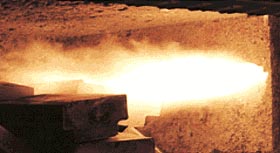
Courtesy of North American Manufacturing Company
A wide variety of burner configurations are used in aluminum melting equipment. The basic categories include those listed below. Click on a burner category for more information.
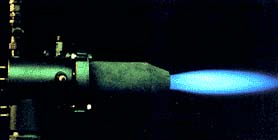
Courtesy of Eclipse Combustion.
Conventional – Conventional burners are the most widely used burners in aluminum furnaces. These burners are either used to heat the refractory brick which radiates energy to the aluminum charge, or to transfer heat directly to the aluminum charge through flame impingement.
Direct flame impingement increases the heat transfer efficiency, but also increases the metal oxidation loss. These burners are typically non-premixed diffusion burners without air or furl staging or regeneration.
 Eclipse ceramic immersion burner mounted in an
Eclipse ceramic immersion burner mounted in analuminum holding furnace.Courtesy of the American Gas Association.
Immersion – Immersion burners have been developed for aluminum melting with limited success. The burner housing is immersed in the molten aluminum and a pre-mixed burner provides hot combustion gases which are circulated through the housing. The combustion gases never come into contact with the molten aluminum, thus oxidation losses are minimized, and the submerged burner provides enhanced heat transfer to the molten charge, thus improving efficiency. Aluminum melting efficiencies of 60% to 65% have been achieved by an immersion burner developed by British Gas Midlands Research Station. In a demonstration of these immersion burners, the life of these tubes were extremely variable with an average life of approximately 2 days to over 9 months. Difficulties have been encountered in commercializing a submersible burner which is durable enough to withstand the conditions within the molten aluminum bath.
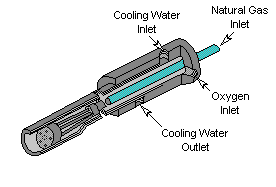
Oxygen Enriched – Replacing part or all of the combustion air with pure oxygen can significantly increase the combustion temperature of furnace burners. Increased burner temperatures in turn decrease the amount of gas needed. As an example, in aluminum melting application, a 7% enrichment with pure oxygen resulted in a 27% increase in aluminum melting rate, and a 24% reduction in gas consumption (ALCAN Oswego Works, GRI-93/0214 report). Oxygen enrichment also provides the benefit of reducing NOx emissions.
There are three main approaches to oxygen enrichment:
Undershoot enrichment – Undershoot enrichment consists of injecting oxygen through a lance which impinges on the underside of the burner flame. This increases the flame temperature on the underside of the flame and increases heat transfer to the aluminum charge.
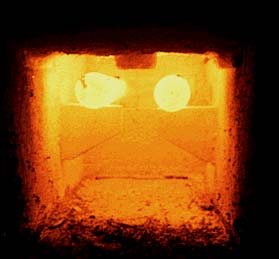 Two Eclipse gas-fired single-end recuperative radiant
Two Eclipse gas-fired single-end recuperative radianttubes in an aluminum holding furnace.
Courtesy of Gas Research Institute.
Radiant Tubes
Radiant tubes are used in applications where reduced metal oxidation and low emissions are of importance. Radiant tubes combust the natural gas inside an inner tube which then passes the combustion gases across an outer tube. The outer tube is made of high radiation emitting material which transfers the heat via radiation to the intended application. The combustion and combustion gases are contained entirely inside the radiant tube and are never allowed to come in contact with the aluminum charge.
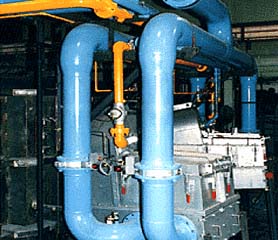
Regenerative combustion equipment installed on an
80,000 lb. central melting furnace.
Courtesy of Frank W. Schaefer, Inc.
Regenerative
Regenerative combustion systems alternate combustion and air preheat through a pair of highly efficient heat storage beds. Combustion are passing through the hot bed is raised to 1,800°F (980°C) providing 30% to 35% better efficiency than with standard radiant roof-fired reverberatory melters. Historical problems with regenerative systems are high NOx production and high maintenance costs.
Regenerative burner technologies are available from a variety of manufacturers including WS GmbH in Germany, Tokyo Gas Co. in Japan, North American, Eclipse, and Bloom. F.W. Schaefer is the first aluminum furnace manufacturer to apply regenerative combustion to aluminum melters; they have installed several systems in the U.S.
